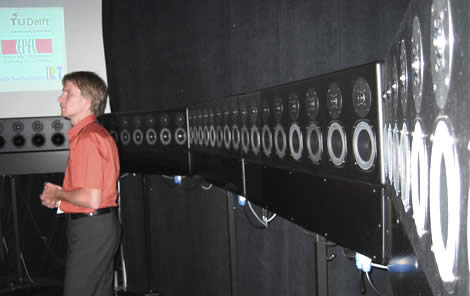Karlheinz Brandenburger. Fraunhofer Institut Integrierte Schaltungen (IIS).
These names may not strike a chord with you right away, but they have undoubtedly had an influence on your experience of audio and music.
Karlheinz Brandenburger is a leading researcher in audio technology, and head of the Fraunhofer IIS. He’s also known as “the father of MP3.” Under his leadership, the Fraunhofer Institut developed the MP3 audio encoding format that has transformed the music and audio industries over the past 10 years.
Whether you love or hate the consequences of that revolutionary research, there’s no denying its transforming impact.
And now they’re at it again – except that this time, the research is leading in the opposite direction on the audio quality scale.

Hundreds of low-cost, full-range speakers create an unlimited number of apparent channels and audio point sources in the Wavefield Synthesis demonstration at the AES/Banff International Conference on Multichannel Audio
One of the most prominent topics at the Audio Engineering Society’s International Conference on Multichannel Audio taking place in Banff, Canada – as well as the most compelling practical demonstration – is Wavefield Synthesis.
Along with Mr. Brandenburger and Fraunhofer IIS, practical Wavefield Synthesis (WFS) has been developed by a European research consortium called Carrouso, with participation by Studer, France Telecom, and several other research facilities, including France’s IRCAM, Delft University (The Netherlands) and the Institute for Broadcast Technology (IRT, Germany).
Briefly explained, WFS makes it possible to create and control an audio soundfield in which the “sweet spot” (the area where the apparent spatial representation of the audio being reproduced is ideal) is practically the entire room. It can be applied to rooms of pretty well any size, so the technology can be used in movie theaters, concert halls, or living rooms.
WFS doesn’t just deliver an enormous “sweet region.” It also provides a spatial image of very high resolution and stability, and allows audio engineers and producers to manipulate the placement of sounds with unlimited flexibility.
So for instance, you might decide to simulate 2 speakers placed in the normal stereo system L/R configuration in a WFS room, and re-create playback of a regular 2-channel recording. Or you could simulate a 5-channel surround system, by placing virtual speakers appropriately. Or a 100-channel surround system!
Wherever you stand (or sit) in the listening area, the “left” and “right” or “front” and “rear” audio signals will appear to be in the correct position for optimal listening.
But this only scratches the surface of the possibilities of WFS. Why bother emulating loudspeaker setups, when you can simply mix your music in WFS? In other words, place the various instruments, effects and elements of a multitrack recording in “virtual pan spots” throughout the listening space.
This may sound like wishful thinking, but the amazing thing about WFS is that it actually works, exactly as described. The audio professionals attending the AES Banff conference have been able to hear for themselves that Wavefield sounds great. The potential appears to be unlimited.
In the context of multichannel technology, WFS effectively eliminates the discussion of “how many channels are enough” by putting an unlimited number of channels into play (although the analogy to “channels” isn’t really appropriate).
Let’s put it this way: if Wavefield Synthesis becomes practical – and it may become practical in as little as a few years – the jump from 5.1 surround to WFS will be at least as dramatic as the jump from 2-channel stereo to 5.1 surround. I’d say quite a lot more dramatic.
Now here’s the problem. WFS requires massive number of loudspeakers. The system installed for demo at AES Banff (see photo) involved about 200 drivers, arranged in panels containing 8 two-way speaker systems and 8 50W amplifiers each. Ideally, the speakers encircle the listening area completely.
WFS technology depends on this concept of an array of closely-spaced loudspeakers. It also requires a great deal of digital signal processing power to perform “convolution” of the audio signals with appropriate filters that create the virtual spatial representation.
The computer processing requirement is much less of a practical concern than the quantity of loudspeakers involved.
Karlheinz Brandenburger has no qualms about the practicality of Wavefield Synthesis. For applications in movie houses, it’s already here. A theater in Ilmenau, Germany is already in operation with a fully-functioning WFS sound system (89 seats, 24 WFS panels with a total of 192 speakers), and more cinema and live-performance theaters, in Germany and elsewhere, will be equipped with WFS later this year.
For the home? Well, WFS speaker arrays work just fine as flat panels, they can be architecturally integrated with living spaces in any number of ways. WFS doesn’t require exotic or costly speakers, just ordinary low-cost full-range drivers (and presumably a subwoofer or two to handle the bottom end). So it may not be too far-fetched to imagine WFS in the home.
So heads up, audiophiles and home theater installers: start thinking about re-configuring your listening spaces to accommodate a truly “surround” loudspeaker technology. When it arrives, WFS audio for the home will be stunning.
The AES 24th International Conference Multichannel Audio: The New Reality continues in Banff through Saturday (June 28, 2003).
Kevin Elliott
Speak Your Mind
You must be logged in to post a comment.